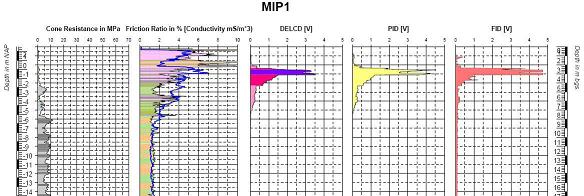General information
Soil and groundwater are contaminated with CVOC due to activities of a former laundry facility. By order of the local competent authority, an additional assessment has been carried out in order to gain a better understanding of the character, the amount and the location (especially of NAPL phase) of contaminants and the transport routes.
Research Objective
The aim of the project is to complete the site conceptual model in favour of the design of an efficient remediation plan. Especially a better understanding of the location of several plumes and sources is required. This will enable a better estimation of the migration of the contaminants. As a result of the buildings covering the entire target area, assessment and remediation options are limited. Through secondary methods, the source area of the contamination has been investigated.
Study
The research area is located in the historical centre of a city in the western part of the Netherlands. The location is being used for shops, cafes and houses. The entire location (approximately 3,000 m2) is built-on.
At two separate locations, PER has been detected in the soil. TCE an VC have been migrated in the groundwater to a depth of 56 m below surface, to the basis of the aquifer.
Methods
Existing monitoring data have used as basis. Additional data about contaminants, groundwater movement, migration and degradation have been gathered by regular and innovative analyses on existing and new monitoring wells, MIP (Membrane Interface Probe) measurements and modelling.
Results
Results show that several sources and plumes exist. As opposed to the former conceptual mode, results indicate the presence of NAPL phase. Rebound and migration to the groundwater will continue for many years to decades. Monitoring data and modelling have resulted in knowledge about degradation and migration (velocity and directions).
 Figure: MIP data indicate the depth of NAPL in the soil profile.
Figure: MIP data indicate the depth of NAPL in the soil profile.
 Figure: MIP data indicate the depth of NAPL in the soil profile.
Figure: MIP data indicate the depth of NAPL in the soil profile.Conclusions and Recommendations
Based on the new insights the site conceptual model has been improved and recommendations have been provided for monitoring and remediation at this inaccessible location. Optimization of the conceptual model was mainly the result of better understanding of the existence and location of NAPL (e.g. based on the MIP data) and a better understanding of migration of the contaminant in groundwater (based on groundwater modelling and CVOC data). It is demonstrated that reliable information about migration and NAPL is crucial. The results provide an indication of the potential of natural degradation proceses to limt migration to specific protection areas.
Attached reports:
indutch_reportcharacterization
Related techniques and cases
Related techniques:
Related cases:
